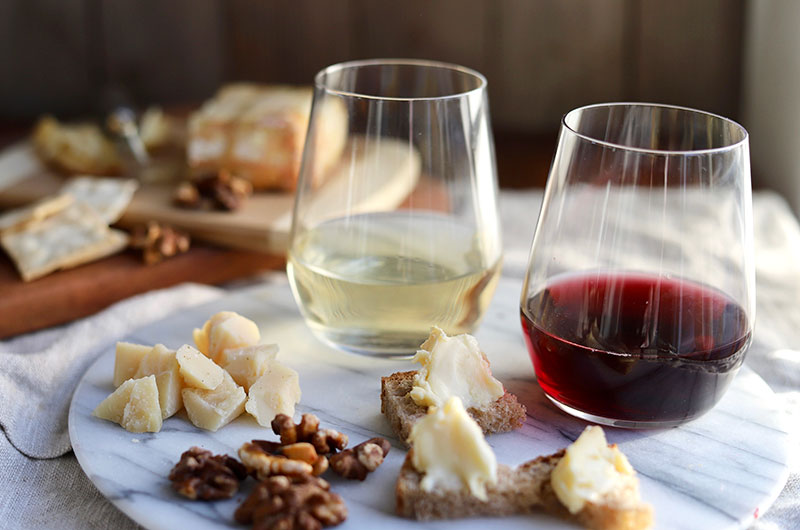Wine and cheese are a versatile combination. They can be served almost anytime (well, usually after noon) and enjoyed by anyone who isn’t lactose intolerant.
Putting wine and cheese together can be as easy or as difficult as you wish to make it. The wonderful interchange of the two in your mouth takes both the wine and the cheese in different directions. Our mouths recognize five tastes: sweet, salty, bitter, sour, and umami (meaty). Depending on your wine and your cheese, the taste may move from one taste to another or stay in the same realm.
In terms of the wine we consume, our local wine shops either carry or can source pretty much anything that is brought into the Commonwealth. We are able to get wines from virtually everywhere and at all sorts of price points. We can get cheese from everywhere too, but we are lucky to be able to find not only washashore cheeses in our grocery stores, but wonderful cheeses made right here on the Island.
While both washashore and local cheeses range in flavors, in textures, and in styles, my focus in this conversation is the local cheeses from The Grey Barn and Farm and Mermaid Farm. The Grey Barn cows are predominantly Dutch-belted and Normandie. The Mermaid cows are mostly Jersey. These beautiful cows, their diet, and the cheese maker’s techniques combine to make cheeses that hit different taste buds and play into different tastes. Each of their cheeses will change in your mouth as the combination of the chemicals in the wine and cheese hit different taste receptors and swirl into different sensations. A lot of biology, I know! You might be interested to know that the sensations in your mouth may not be the same as those tasted by your wine and cheese partner.
What’s the occasion?
In putting cheese together with wine, I want to know the occasion. Am I throwing something together for a snack while reading or am I keeping my mouth happy while watching the Patriots? Am I serving friends an hors d’oeuvre before a meal? Or am I going all continental and serving the wine and cheese “après” the main course and before dessert?
With a snack: For that snack or football game, I want lighter or medium taste in both the wine and the cheese. I also want to be sure not to put too much in front of me as I don’t want to spoil dinner. I want Mermaid Farm’s Fromage, either plain or herbed, for a clean, moist, tangy taste in a soft cheese. For a harder texture and fruity, faintly caramel taste, I’m happy with a Grey Barn Rip Rap. I want a red wine with these cheeses. I also want a low-alcohol content wine, so my face doesn’t drop into my book or my eyes don’t close during a touchdown. I’d like a fruity Pinot Noir, a Valpolicella or maybe something easy drinking from Abruzzo. Maybe a lighter California Zinfandel?
Before the meal: Serving the cheese and wine before the meal, you don’t want taste overkill as you want to leave your mouth ready for dinner. A lighter wine paired with a sharp cheese to wake up the palette is a good kick-off. With a cheese like a King’s Highway from Mermaid, you want to balance the bright, acidic taste and its mushroomy rind with a dry white wine – think Vernaccia for Italian or Sancerre for French or un-oaked Chardonnay for American. For a red, I’d open an Oregon Pinot Noir, a new Beaujolais or a South African Pinotage. These wines are light- to medium-bodied, they will work well with the cheese, and they won’t overwhelm prior to dinner. As an alternative, a dry clean sherry (not Granny’s sweet syrup), maybe with an ice cube, can be a pleasing alternative.
After the meal: If you’re having your cheese after the meal, it’s going to have to be flavorful and ripe to follow your food and wake up your already belabored taste buds. Your wine is going to have to stand up to a big cheese and stand out from the dinner’s wine. Try a Grey Barn Prufrock. It’s yeasty with the flavors of carrot and fruit, and has a great-tasting rind as well. a carrot/fruit taste and a great rind. The Prufrock will stand up not only to your meal, but will also hold its own with a great big red wine. American Cabernet, Australian Shiraz or Italian Sagrantino are wines that share big robust flavors and strong fruit. They will hold their own in your mouth. They are also on the upper end of the alcohol content; you might want someone else to take the car keys!
Blue Cheese and Port: Lastly, let me talk quickly about blue cheese and Port. Grey Barn’s Bluebird – the reserve with its black pepper taste – is a wonderful local blue cheese. Blue cheeses are often served after a meal accompanied by fruit, jams, or compote (fig and ginger is a favorite of mine). Port is the traditional pairing with a blue cheese – from a creamy Gorgonzola to a hard Stilton to a crumbly Roquefort. But before you pour that big snifter of Port to close your evening, remember Port is fortified; brandy is added before the wine has finished fermenting. It’s an old pre-refrigeration trick from the days of sailing ships to keep the wine from spoiling during shipping. Fortified wine + after dinner = again, give someone else the car keys!
There are other cheeses and other wines. Despite all the fancy food words and stylish wine articles, it doesn’t have to be complicated. There are lots of options. Keep yourself happy. Anytime. A personal happy afternoon option is a slice of block cheddar on a Triscuit, accompanied by a cold can of Narraganset. Beautiful. “Hi, neighbor!” It doesn’t have to be complicated.
Where to find local cheese:
If you’re interested in buying local cheese, you have many options on the Island. Stop by the farm stand of The Grey Barn and Farm (or their booth at the winter farmers’ market) to pick up Prufrock, Eidolon, Bluebird, Bluebird Reserve, and Rip Rap. Grey Barn cheeses are also available around the Island at Morning Glory Farm, Le Roux Gourmet and other retailers. If you’re off-Island, Grey Barn is distributed to cheese sellers all over the East Coast, including Murray’s Cheese in New York, and in California.
You can pick up Mermaid Farm’s feta, fromage, King’s Highway, Nobska, Tomme, and Carding Mill Blue at their farm stand on Middle Road and at Morning Glory Farm.
A cheese tip from Jim Malkin: Our local cheeses (those that are aged) deepen in flavor and their textures change as they sit in the refrigerator case of a retailer or in your refrigerator at home. Jim prefers a stronger, more developed taste, so he often buys a local cheese several weeks before he knows he will serve it, then keeps it in the back of the fridge until just around or right after the sell-by date.




 2 comments
2 comments


Comments (2)